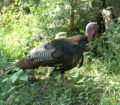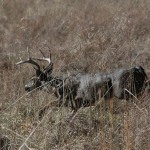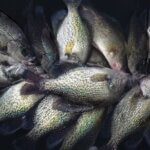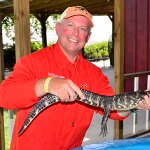Editor’s Note: With turkey season opening in a month in Florida and then mid-March in some of the South, we need to remember that tough turkeys teach us difficult lessons. Let’s listen to some of the best turkey hunters in the country tell us about the tough turkeys they’ve tried to take.
After Rod Haydel from Bossier City, Louisiana, and the president of Haydel’s Game Calls (www.haydels.com), harvested several turkeys, he thought he knew all he needed to know about turkey hunting. “I scouted an area in north Louisiana, just south of my hometown, the evening before I planned to hunt the next morning,” Haydel says. “Although I didn’t hear any turkeys in the afternoon, I returned to that same spot the next morning and heard several gobblers and some hens. As I called, I heard the gobbler I was hunting walk steadily away from me. I circled, got in front of him and called to him again, but the turkey turned and walked away from me a second time. Although I circled those turkeys four or five times, I never could get them to come to me.
“Finally, I set-up in a creek bottom and called the turkeys, which then came toward me. I finally realized that each time I thought the turkeys were going away from me, they actually were going around another bend in the dry creek bottom. So, the flock had been moving toward me the entire time, they just weren’t coming in a straight line. The birds had taken the path of least resistance by walking along the creek bottom through the pine plantations bordering the creek. When the birds came in sight, I saw two mature gobblers and shot the biggest, which weighed 23 pounds and had an 11-1/8-inch beard. I learned from that hunt that often when a hard-to-take turkey sounds as if he’s walking away from you, he may be taking an easier route to get to you.”
“I heard an old gobbler behind my house in Cadiz, Kentucky,” David Hale, co-creator of Knight and Hale Game Calls (www.knightandhale.com), says. “I decided to save this gobbler and not hunt him until I had a special client who wanted to kill a turkey. When I finally took a client out to the ridge behind my house, I used a call to make a little cutting sound. The gobbler answered and came in view of the crosshairs of my client’s gun. We took him.
“I planned to guide another client later on in the season. I already had taken all the gobblers I’d located before the season and hadn’t found a bird to call for this hunter. Out of desperation, I took him behind my house in hopes that a turkey had slipped in to take over the territory of the gobbler we’d already killed. I called, and once again, a turkey appeared on the ridge, just like the first turkey. With little or no problem at all, we bagged the second bird. I couldn’t believe that we got this bird. All season long, I only had heard one turkey gobble behind the house.
“During the last few weeks of the season, I had another client come in to hunt, but I couldn’t find a turkey for him either. I went to the same ridge, sat down in the same spot and used the same call. A turkey gobbled from the same spot as the previous two turkeys. With just a little bit of calling, I brought the bird in, and we bagged him.
“On the last day of the season, I decided to hunt by myself. I went behind the house and called. Once the bird came in, he stayed out of sight. I could hear him strutting and drumming away from me and heading for the next ridge. I moved to the ridge. When the turkey began to strut and drum away from me, I left the ridge, made a big circle and got on another ridge where I hoped the turkey would head. When the bird came up the ridge like I thought he would, I took him. This large, old gobbler was the boss gobbler. He wouldn’t permit the other three gobblers to gobble. He’d gobbled from the same spot. When one of these other three gobblers heard the hen, he’d gone to her silently, and we’d kill him. So, each day I actually had been hunting this ole bird.”
 Hale on High-Pressured Turkeys:
Hale on High-Pressured Turkeys:
Hale has hunted high-pressured turkeys for many years and reports, “When turkeys feel too-much calling pressure or hunting pressure, the turkeys will leave their homes (roost areas) and move to another region where they can see hunters coming. Gobblers have certain regions where they strut, drum and remain visible to hens without ever actually having to gobble. A turkey also can see a hunter approach from these locations. Often a tom will strut on hills or ridges where he can see all the way down the ridge and on either side of the hill.
“I like to hunt where I can find two high points of land on a ridge with a saddle in the middle. A turkey generally will strut and drum on the other high point. If I take a stand in that saddle, I’ll get a shot at the gobbler – either going or coming. When a hen wants to breed, she’ll move close to that strut zone to listen to the tom drum and strut. Once I get to the strut zone, I only call about one-tenth as much as I will in an area where the turkeys don’t feel hunting pressure. I’ll usually cluck once or twice, give three soft yelps and then wait 10 minutes before calling again. A gobbler will come forward two or three steps, strut, drum and keep looking for the hen. When he doesn’t see her, he’ll walk two or three steps, strut and drum once more. He’s trying to get close enough to see her or let her spot him without actually having to commit himself to going to her. To take this gobbler, you must be patient. Don’t rush the turkey into coming toward you.”
To learn more about turkey hunting, check out John E. Phillips’ print, Audible and Kindle turkey books at https://johninthewild.com/books/#turkey. For a free copy of John E. Phillips’ “The Turkey Gobbler Getter Manual,” go to https://johninthewild.com/free-books/.












